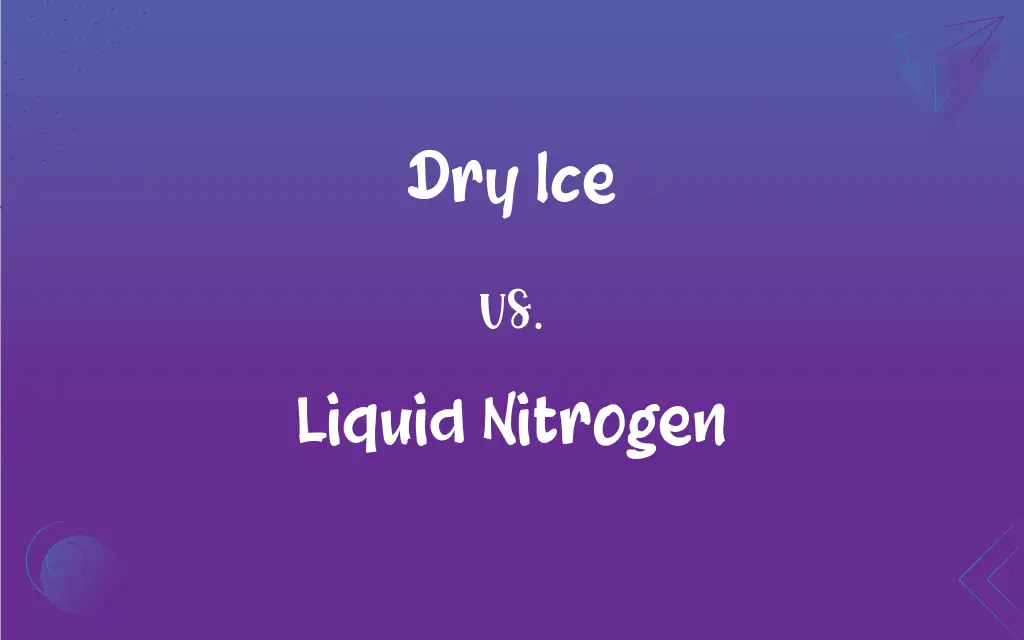Dry Ice vs. Liquid Nitrogen: What's the Difference?
Edited by Aimie Carlson || By Janet White || Published on January 8, 2024
Dry Ice is a solid form of carbon dioxide, used as a cooling agent. Liquid Nitrogen is nitrogen in a liquid state at extremely low temperatures, used in cryogenics.

Key Differences
Dry ice is the solid form of carbon dioxide (CO2) and sublimates directly into gas without passing through a liquid stage. Liquid nitrogen, conversely, is nitrogen in a liquid state, obtained by subjecting nitrogen gas to very low temperatures and high pressure.
In terms of temperature, dry ice is colder than water ice, typically at -78.5°C (-109.3°F), making it an effective cooling agent. Liquid nitrogen is much colder, at about -196°C (-320.8°F), and is used in applications requiring extreme cooling.
Dry ice is commonly used for refrigeration, especially for transporting perishable goods and for creating fog effects in entertainment. Liquid nitrogen has diverse applications, including cryopreservation, cryosurgery, and culinary uses for flash freezing.
Handling dry ice requires care to avoid skin burns and adequate ventilation due to CO2 gas release. Liquid nitrogen requires even more caution in handling due to its extremely low temperatures, which can cause severe frostbite upon contact with skin.
Dry ice doesn't leave a residue, as it sublimates directly from solid to gas. Liquid nitrogen, when it evaporates, returns to the nitrogen gas, which is non-toxic and inert, making it safe in ventilated spaces.
ADVERTISEMENT
Comparison Chart
Composition
Solid carbon dioxide
Liquid state of nitrogen
Temperature
-78.5°C (-109.3°F)
-196°C (-320.8°F)
Uses
Refrigeration, fog effects
Cryopreservation, cryosurgery, culinary uses
Handling Precautions
Avoid skin burns, ensure ventilation
Extreme caution for frostbite, require ventilation
Residue
Sublimates to gas, no residue
Evaporates to nitrogen gas, no toxic residue
ADVERTISEMENT
Dry Ice and Liquid Nitrogen Definitions
Dry Ice
Sublimates directly from solid to gas.
The dry ice created a misty effect by sublimating at room temperature.
Liquid Nitrogen
Nitrogen in a liquid state at very low temperatures.
Liquid nitrogen is used in cryogenic freezers.
Dry Ice
Does not leave a wet residue.
Dry ice is preferred in situations where moisture can cause damage.
Liquid Nitrogen
Can cause severe frostbite upon contact with skin.
Handling liquid nitrogen requires protective gloves.
Dry Ice
Solid form of carbon dioxide.
They used dry ice to keep the food frozen during transport.
Liquid Nitrogen
Evaporates to nitrogen gas.
In well-ventilated areas, the evaporation of liquid nitrogen is safe.
Dry Ice
Used as a cooling agent.
Dry ice is ideal for shipping medical samples.
Liquid Nitrogen
Used in cryopreservation and cryosurgery.
Liquid nitrogen is essential for preserving biological samples.
Dry Ice
Colder than water ice.
Dry ice keeps things frozen longer than regular ice.
Liquid Nitrogen
Has a temperature of about -196°C (-320.8°F).
The extreme cold of liquid nitrogen can instantly freeze food items.
FAQs
How cold is dry ice?
About -78.5°C (-109.3°F).
What temperature is liquid nitrogen?
Around -196°C (-320.8°F).
Can dry ice cause burns?
Yes, it can cause cold burns upon direct skin contact.
What is dry ice?
Solid carbon dioxide used as a cooling agent.
What is liquid nitrogen used for?
In cryopreservation, cryosurgery, and culinary arts.
Is dry ice safe for food transport?
Yes, it's commonly used to keep food frozen during transport.
What is liquid nitrogen?
Nitrogen in liquid form at extremely low temperatures.
What are the uses of dry ice?
In refrigeration, transport of perishables, and creating fog effects.
Does dry ice melt?
No, it sublimates directly from solid to gas.
What happens if dry ice is sealed in a container?
It can cause the container to burst due to gas buildup.
Is liquid nitrogen environmentally friendly?
Yes, as it evaporates back into harmless nitrogen gas.
Can liquid nitrogen freeze alcohol?
Yes, it can freeze alcohol and other liquids quickly.
How long does dry ice last?
It depends on the insulation, but typically a few hours to a couple of days.
Is liquid nitrogen safe to touch?
No, it can cause severe frostbite.
Can you cook with liquid nitrogen?
Yes, it's used for flash-freezing in culinary applications.
Is liquid nitrogen used in medicine?
Yes, particularly in cryosurgery and preserving biological samples.
How should liquid nitrogen be stored?
In well-insulated containers designed for cryogenic liquids.
What precautions are needed for dry ice?
Use gloves for handling and ensure good ventilation.
Can dry ice be used in drinks?
Yes, for creating a fog effect, but it shouldn't be ingested.
How do you dispose of liquid nitrogen?
Allow it to evaporate in a well-ventilated area.
About Author
Written by
Janet WhiteJanet White has been an esteemed writer and blogger for Difference Wiki. Holding a Master's degree in Science and Medical Journalism from the prestigious Boston University, she has consistently demonstrated her expertise and passion for her field. When she's not immersed in her work, Janet relishes her time exercising, delving into a good book, and cherishing moments with friends and family.
Edited by
Aimie CarlsonAimie Carlson, holding a master's degree in English literature, is a fervent English language enthusiast. She lends her writing talents to Difference Wiki, a prominent website that specializes in comparisons, offering readers insightful analyses that both captivate and inform.






































































